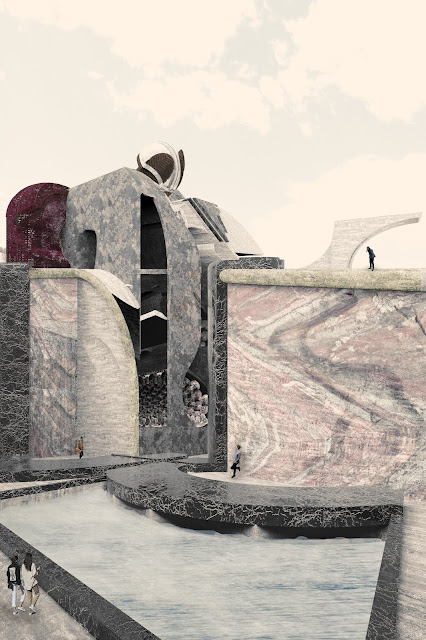T4T LAB Spring 2018. Rough and Saturated
Invited Professor: Nate Hume
Team: Madison Green, Finn Rattana, Ray Gonzalez, Lauren Miller
Our
project is an investigation into the use of interlock as an estrangement
technique, that when implemented across Ground, Material, Surface, Line, and
Volume, creates ambiguity from their overlap that seeks to operate outside
digital tropes, producing objects that confound the boundaries between these
conditions.
Interlock
is an operation that fuses objects together while creating an edge. It is a
characteristic inherent of objects created in the physical world, connecting
parts by gluing, welding, joining, sewing, riveting, among others depending on
the material in use, and is frequently moved to the background of our
consciousness. The building seeks to implement vaguely similar qualities of
interlock to inject a sense of familiarity, and misuse these qualities as
Surface, Material, Ground, Line, and Volume, extracting the functional
preconceptions of their traditional use from their now estranged figuration.
Interlock
operates as Volume via implied geometric articulations of separate parts.
Interlocked parts suggest an unfixed disposition, puzzle pieces that were
assembled, or perhaps are intending to move or shift. At times parts may match
seamlessly and at other moments are misfit, forced together against their
geometric will to create a difficult interlocked whole, and the scale and
inhabitability of these volumetric interlocks serve to further displace our
preconception of their traditional use.
The
Site specifically influences our conception of alignment and misalignment, with
vegetation jumping across roads and paths, or ignoring these boundaries
altogether, or embedding unnatural geometric figuration with the vegetation
itself.
Interlock
serves to diminish any hierarchy between Building and Ground, and creates
ambiguity in differentiating which of the two categories parts belong to.
Ground serves as a way of displacing inside and outside conditions across the
site by giving enhanced interior qualities to the non centralized points of the
complex and enhanced exterior qualities to the most central point of the
building’s mass. Ground and Site begin to operate as Volume, Surface, and Line
with the top layer of the land separating from it’s vertical edges, or becoming
tensile volumetric lines interacting with the building. These moments are expanded
upon with Material and Texture.
Texture
is derived from familiar architectural and geological sources and maintain
their traditional scale, but are subtly distorted to become unfamiliar via
Color and Materiality. The misalignment of textures to aforementioned
fluctuating typologies results in a hybridized materiality, relying on a
different system of interlock that is mildly aware of the system of geometric
interlock the project establishes volumetrically. At times Textures align to
these underlying moments, but also smear across the implied division of parts,
producing new conditions of discontinuous interlock that operate between
Volume, Surface, Line, and Material.
Hybridization
is critical to our interpretation of the project’s program as an addition to
the Crop and Soil Sciences Department in the College of Agriculture, to which
we have assigned a mixed use as Plant Hybridization Facility and Soil Analysis
Center. The Building and Site catalyze this program to produce strange
architectural qualities, specifically in the large plant volume in which
vegetation begins to behave as dynamic poche growing between the layers of the
double shelled metal mesh, in the seed vault with pods for containing each
generation of seeds the facility produces through experiments in selective
breeding and genetic manipulation, in the site’s pits that monumentally reveal
the underlying sediment of the site to visitors, and in the central soft serve
space which displays a gallery like array of soil samples currently contained
in the college.
These
moments disrupt the edges between the work produced in the Crop and Soil
Sciences Department and the access to that work, and reinforce the overlapping
hybridized interlock and material conditions produced by the project.


















